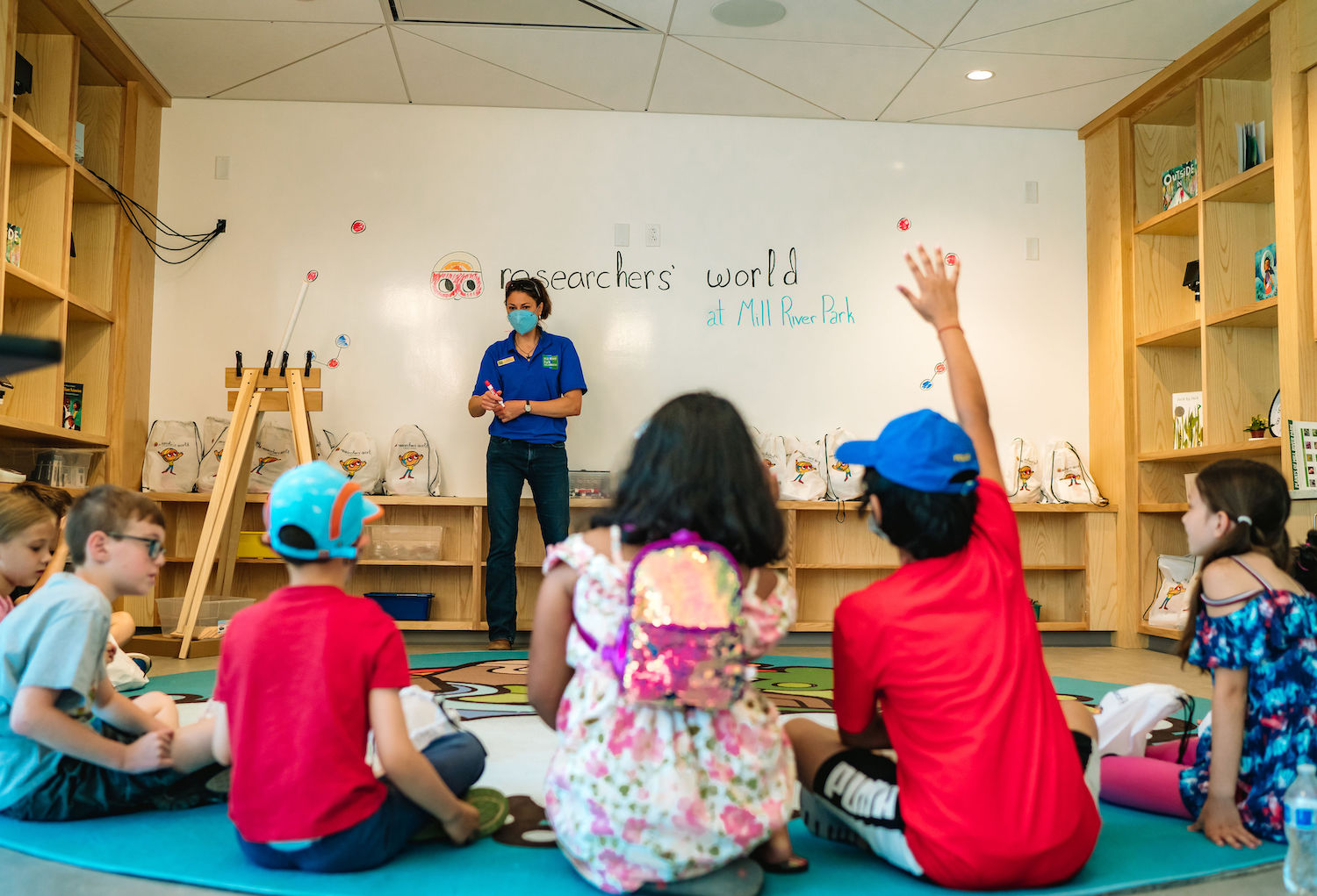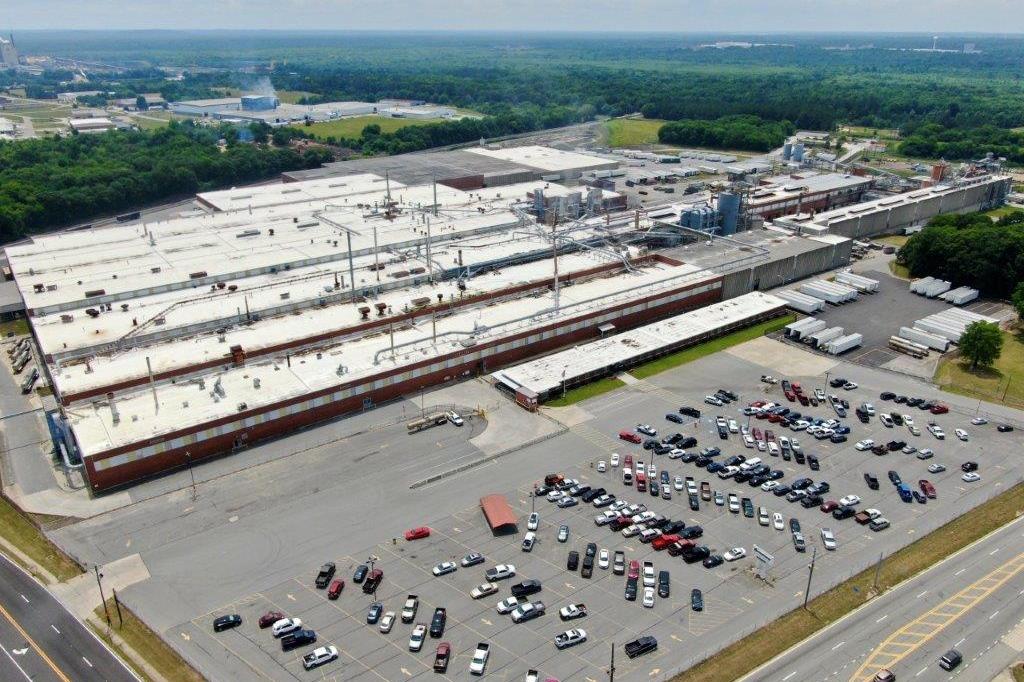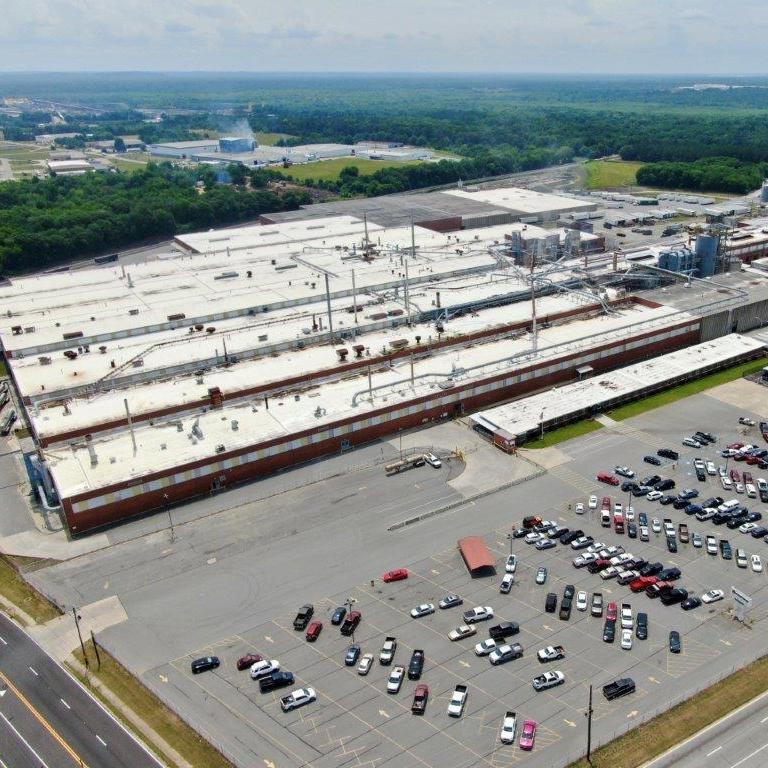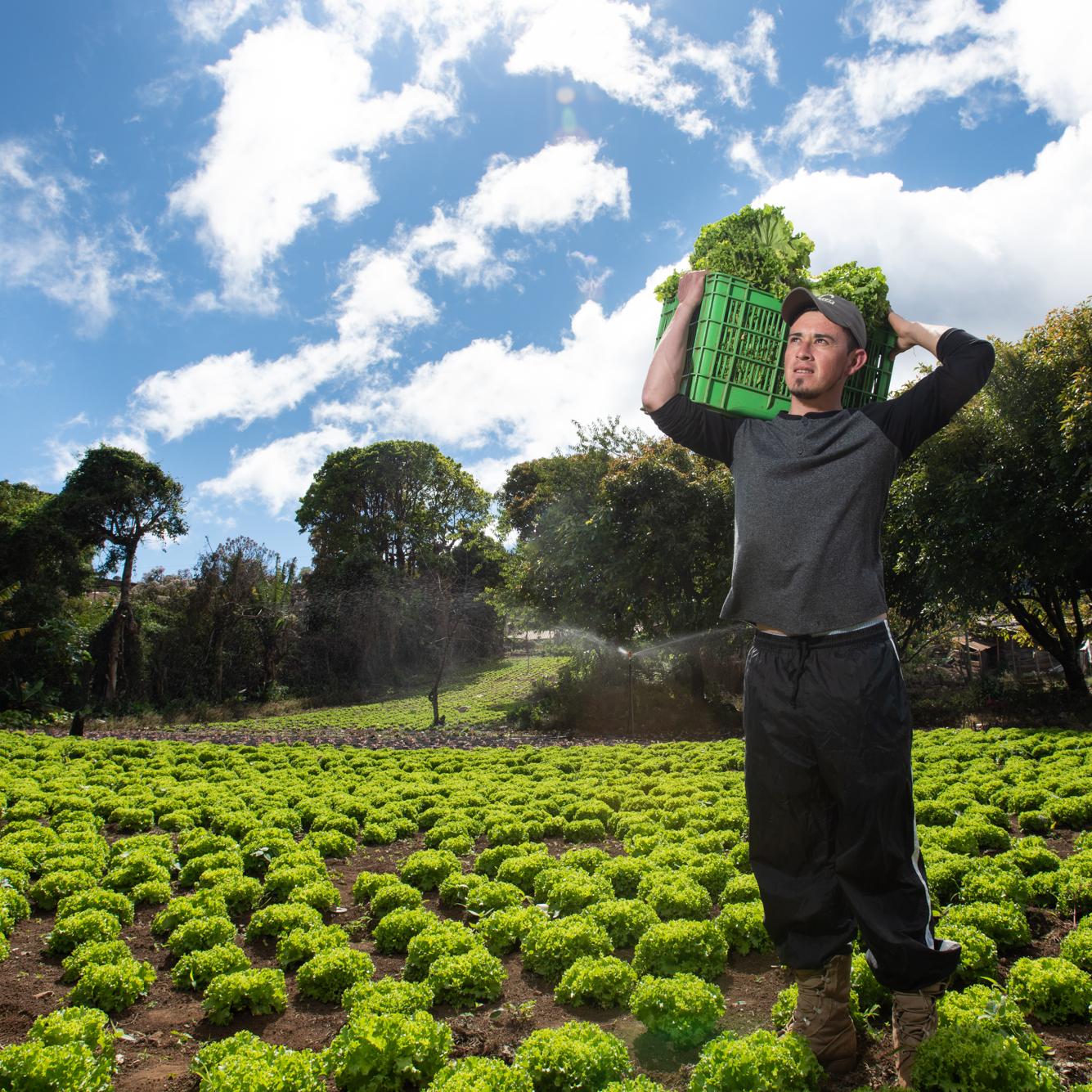A Bright Idea for Promoting STEM Education: Bring It Into Community Spaces


Local flowers grow outside of the recently opened Whittingham Discovery Center at Mill River Park in Stamford, Connecticut.
A new education center at a riverfront park in Stamford, Connecticut, is connecting the community to nature and teaching applied science to promote sustainability and inspire the next generation of science, technology, engineering and math (STEM) professionals. As climate change and biodiversity loss accelerate, motivating people to care about how their actions and career choices affect the environment is more important than ever. The nonprofit Mill River Park Collaborative is a shining example of how local projects can benefit from corporate partnerships and strive for big impacts with long-term results by connecting the community’s youth to relevant hands-on science and environmental instruction.
From a “trash dump” to a revitalized ecosystem and community center
Mill River Park was a long time in the making, almost a century if the town’s forgotten plans count. Before the park opened in 2013, the area was far from the lush blue and green space that planners imagined. Instead of being a locus for families and recreation, “It was basically treated like a trash dump,” Kristia Janowski, the park’s director of education and sustainability, told TriplePundit candidly.
Transforming the waterfront was a group effort spanning decades and involving the U.S. Army Corps of Engineers. The Corps removed two dams and concrete channel walls, restoring the river banks to a natural state. By doing this, they made it possible for the river banks to absorb excess floodwater, effectively removing the 100-year floodplain from downtown Stamford, Janowski explained.
Mill River Park Collaborative grew out of a partnership between the city of Stamford and The Trust for Public Land. They are tasked with maintaining and continuing the restoration after the Corps left, Janowski said. No less important are the countless volunteers, companies and organizations that continue to help the Collaborative maintain the river, native meadows and green space today, making it truly a community endeavor.
New science center looks to connect locals with nature
As exciting as the riverfront’s metamorphosis has been, the recently opened Whittingham Discovery Center makes Mill River Park extra special. In describing the educational space that has been a part of the plan for the park all along, Janowski said, “It’s about connecting people with nature.”
The building itself is symbolic of this goal. It was constructed to emulate the natural environment and use solar panels, with the expectation that it will supply roughly 85 percent of its own energy. The center is curated with museum exhibits relevant to the local area, including fish tanks that house local species. Classrooms throughout the complex — including one made possible by a partnership with Henkel North America — focus on how STEM fields relate to nature.
The park rang in its first field trips and test classes this past spring. Full programming will start in the fall with grades three to five and will eventually expand to include students from kindergarten through high school. “Classes will explore a concept through experiments in the lab, and go outside to discover how that same concept shows up in the natural world,” Janowski said. Lessons will cover topics like sustainability, conservation of energy, waste reduction, biomimicry, reduced packaging, solar panels and more.
“Ultimately this is going to be a place to broaden awareness of sustainability and environmental issues,” Janowski said, adding that the park will “provide a place for people to connect to nature in a city environment.” As for the goals of the park and the science center, she hopes to help people make that connection with nature first and then teach them the science behind the natural environment. “When we realize we’re connected, we care more,” she said.

A corporate partnership helps bring local STEM education to life
The educational programming provided in the science center’s classrooms will be a big part of achieving those goals. One of the classrooms is sponsored by Henkel North America as part of its youth STEM outreach program, Researchers' World, which has already reached 81,000 children in 19 countries. “The classroom features science lab equipment and workstations customized for up to 20 elementary-school-aged children,” said Jennifer Schiavone, Vice President, Corporate Communications, Americas and the program’s executive sponsor at Henkel in North America. A mobile Henkel Researchers' World Discovery Cart serves as a weekend extension of the classroom, reaching students throughout the park with interactive lessons.
Janowski described the classroom as very kid-focused, with fun cartoon canvasses and a colorful Researchers’ World rug designed to create an inspiring atmosphere for learning. Educators will partner with Henkel to inspire students in the local community using Henkel lessons that have been developed in partnership with a leading university in Germany and adapted for the park. One such lesson is on adhesives, which involves lessons in the lab and a trip into the park to observe naturally sticky substances — reinforcing what students learned in the classroom.
The partnership between Mill River Park and Henkel is one of shared purpose and vision. “We’re passionate about growing Henkel Researchers' World in North America to help reach the next generation of scientists and spark their curiosity around STEM learning,” Schiavone told us. “Setting up our dedicated classroom helps us meet the need to reach more children with STEM education in a growing and diverse local community.”
In fact, Mill River Park is in a prime location to bring STEM education to a diverse and historically underserved community. While the river used to act as a boundary between the downtown core and the West Side, Stamford’s poorest area, the greenway now brings the two neighborhoods together. The park is also the ideal place for Henkel North America to get involved — both because its headquarters are located a few blocks away and because of the organizations’ shared values. “The program engages youth with hands-on interactive experiments created to inspire curiosity in science,” Schiavone said.
A legacy of environmental education
“I hope to influence the next generation toward changing how they do their jobs,” Janowski said of the future benefits she anticipates for children who visit the center. As an example, she mentioned an architect and how being introduced to sustainability as a child might affect how they design buildings as an adult. “Get them thinking,” she said. “Long-term, environmental thinking, sustainability-minded, with career fields in STEM.”
For brands looking to merge purpose and profit, Researchers’ World provides an example worth emulating. As a manufacturer of consumer goods like detergents and adhesives, STEM is Henkel’s thing. It’s a natural fit for the company to share scientific knowledge and look to get kids of all backgrounds involved in STEM, as the effort both reflects its purpose and helps it to grow a diverse pipeline of scientists for the future.
Schiavone expanded on why partnering with the Mill River Park Collaborative made sense for the company: “Sustainability drives everything we do at Henkel. Our sustainability strategy is inspired by our purpose: Pioneers at heart for the good of generations. With our pioneering spirit, our knowledge, our products and technologies, we want to enrich and improve the lives of billions of people every day — and shape a viable future for the next generations.”
This article series is sponsored by Henkel North America and produced by the TriplePundit editorial team.
Images courtesy of the Mill River Park Collaborative
Vroom! Porsche Accelerates Investments in Solar and Sustainable Design


So, we’re not exactly talking about a rapid, rocket-fueled, zero-to-60 shift to renewables that will soar anywhere near the pace of the epic lineup of turbo-powered cars that Porsche has rolled out over the years. But you can count in the luxury automaker as the latest within its industry to join the race along the clean energy autobahn.
Earlier this week, Porsche, or technically PCNA (Porsche Cars North America), announced it would invest in a solar power installation — in the form of a sizable microgrid that will generate power for its expanding campus and will be connected to the wider power grid — at the company's North American headquarters in Georgia.
The company that Porsche has tasked with building the installation, Cherry Street Energy, says the solar array at the automaker’s campus will generate 2,050 megawatt hours (MWh) of clean electricity a year, or the equivalent of keeping the lights on at almost 200 homes annually. Crunching the numbers differently, Porsche and Cherry Street Energy claim the amount of renewable electricity generated will result in an estimated carbon emissions reduction of 3.2 million pounds annually, or nixing more than 3.5 million miles of driving by typical passenger cars.
Construction of the installation is expected to begin next month and conclude at some point in 2023. Porsche has inked a 25-year agreement with Cherry Street Energy, and the latter has committed to installing solar panels on current and new buildings that the automaker will add to its headquarters’ campus.
Beyond the construction of the new solar panel installation, the regional Porsche headquarters will showcase additional sustainable design features, including specially formulated concrete that the company says will decrease the amount of embodied carbon; an expansion of water reuse and recycling across the campus, paired with non-irrigated landscaping; and green walls and walking trails that together could boost biodiversity across the campus. New electric vehicle charging infrastructure will also be available for employees and visitors. Porsche expects the campus’ expansion to score gold-level LEED certification.
This isn’t the first time the company has been to the solar power rodeo: For example, an 82-foot photovoltaic pylon at a campus in Berlin included more than 7,700 solar panels, which at its launch several years ago generated 30,000 kilowatt hours (KWh) of clean power.
As far as the electrification of Porsche vehicles goes, the first Porsche-designed electric car dates back to 1898, when Ferdinand Porsche designed the Egger-Lohner C.2 Phaeton a half-century before he founded his namesake company. The automaker started to invest aggressively in electrification technology a decade ago, and recently has started to dabble in electrofuels, a blend of green hydrogen and carbon that could eventually work as a replacement for gasoline and similar liquid fuels.
Image credits: Porschefectionist via Unsplash
The New Abortion Ban Is Not Indiana’s Only Problem


Downtown Indianapolis, Indiana
Just ten years ago, Indiana was poised to lead the nation in clean tech jobs. Now it is facing a human rights crisis that threatens to become a full-blown economic disaster, thanks to a restrictive abortion ban enacted earlier this month. It will be difficult to reverse the ban. However, in a strange twist, the climate change provisions in the newly signed Inflation Reduction Act could help Indiana employers lobby for a return to sanity.
Indiana abortion ban adds fuel to the brain drain fire
The full impact of Indiana’s new abortion law is yet to be seen. However, all abortion bans create a separate class of citizens whose human and civil rights are secondary. In that regard, the new law already puts Indiana employers at a disadvantage for recruiting and retaining top talent. It pulls the rug right out from under their diversity, equity and inclusion initiatives.
Employers in Indiana are particularly vulnerable because the state ranks low in higher education, and the new abortion ban is all but certain to make matters worse.
Editor's note: Be sure to subscribe to our Brands Taking Stands newsletter, which comes out every Wednesday.
Professor Michael J. Hicks, who is the director of the Center for Business and Economic Research in the Miller College of Business at Ball State University, summed up the situation in an op-ed last week. “Recall that Indiana’s workforce ranks near the bottom in educational attainment,” he wrote. “Worse, we’ve seen the college going rate drop a whopping 12 percentage points in just six years.”
Hicks added: “This puts us in the realm of the most economically fragile states in the Union — Mississippi, Louisiana, West Virginia — and just below Puerto Rico. This matters because nine out of 10 college-age people nationwide prefer more expansive abortion access than Indiana now has.”
Indiana is not the only state at risk from the economic fallout of abortion bans, but Hicks emphasized that it is especially vulnerable.
“Businesses locate where they can access abundant workers of the types they need…They come for the right workers, of which we have far too few,” Hicks warned.
“Over the past three decades, more than 80 percent of job growth nationally has gone to college-educated workers. As that trend continues, which it will, Indiana is now at a fraught disadvantage,” he explained.
Connecting the public opinion dots
Overall, Hicks made the case for using public opinion surveys as a guidepost for assessing the economic impacts of any statewide abortion ban.
If that argument holds up, employers in Indiana and other abortion-banning states are in serious trouble.
CNBC reporter Morgan Smith took a deep dive into the details last Friday, citing a survey conducted by the nonprofit women’s empowerment organization LeanIn.org.
“Seventy-six percent of women are concerned that the overturn of Roe is going to hurt their careers, according to new research from LeanIn.Org, which surveyed 3,196 U.S. workers last month. This sentiment is even stronger among women under 40 (84 percent) and women of color (82 percent),” she observed.
LeanIn.org used the SurveyMonkey Audience platform to conduct the survey. If that skewed the responses to some degree, it is still consistent with other findings.
“More than half of U.S. workers (56 percent) wouldn’t even consider taking a job at a company that didn’t share their values according to a Qualtrics survey, which polled 1,178 employees in April,” Smith noted.
“LeanIn.Org’s new report and other recent research highlight a growing desire among employees to work for a company that aligns with their values, both personal and political,” she added.
Indiana employers and the Inflation Reduction Act
These surveys don’t necessarily reflect the actual ability of workers to pick up and move on account of an abortion ban. However, if even a fraction of workers and college students follow through on their sentiments, Indiana is especially at risk.
“The problem is that Indiana has few economic advantages that are relevant to the 21st century,” Professor Hicks noted in his op-ed. “None that we have are sufficient to overcome policies that alienate the vast majority of the mobile, highly-educated young people we so desperately need.”
Hicks also warned that the Republican supermajority in the Indiana legislature has taken an anti-business tack that will push some businesses out of the state.
For those unable to leave, Hicks gently suggests that political activism is the only answer.
“Some businesses cannot leave and will surely look to support more business-friendly voices across the state,” he wrote.
That is easier said than done. Considering the hot mess of religion, misogyny and white supremacy boiling through the anti-abortion movement, fact-based conversations about basic human and civil rights are simply impossible.
Nevertheless, there is a way for employers to talk about the rights of pregnant people in Indiana, without being drawn into a bottomless pit of misplaced morality.
Now that the Inflation Reduction Act has been signed into law, employers can leverage it to lobby for a new clean tech renaissance in Indiana.
The legislation is a massive package of new funding for renewable energy, energy efficiency and other initiatives that help reduce carbon emissions. If Indiana lawmakers are going to ensure that Indiana gets its fair share, they will need to demonstrate that they are serious about administering one of the biggest economic development initiatives in U.S. history.
So far, of course, they have failed dismally
State lawmakers rushed the new abortion ban through in a hastily convened special session, despite behind-the-scenes lobbying by Eli Lilly, Cummins and other businesses leaders that warned of the economic impacts.
Meanwhile, Indiana’s Republican representatives in Congress failed to support the Inflation Reduction Act. They voted in a block against a massive influx of federal dollars into their own state.
That partisan breakdown provides a rational, fact-based, emotion-free platform for business leaders to advocate for electing more Democrats into state and federal offices.
As Election Day 2022 draws near, the Republicans who voted against the Inflation Reduction Act have all but forced Indiana business leaders to choose a side. They can advocate for Democratic leadership on the basis of economic progress in the broadest possible terms, including equal rights for all.
Image credit: Ryan De Hamer via Unsplash
Stop Spying on Your Employees: It’s Creepy, and They’re Probably ‘Quiet Quitting’ Anyway


In case you missed it, the monitoring of workers — whether it’s through tallying up idle time or keyboard strokes — is happening just about everywhere. As employers seek to have staffers return to the office, companies are spending big money on software applications that monitor employees’ activities remotely via their computers. And the spying madness is affecting everyone: financial professionals, social workers and, absurdly enough, even hospice chaplains.
Employers as well as the software companies vested in this space say it’s not about spying, but instead such systems can ensure and boost productivity. Additional commentators have said that remote work needs to end, if not “vanish,” as they insist working away from the office gets in the way of “synergy, collaboration and innovation,” though based on how often those words are tossed about, the bar for what passes as definitions for those three words is very low.
The insanity over how companies have deployed these monitoring systems has reached the point at which employees find themselves defending their decisions to go to the bathroom — as the New York Times recently profiled — or getting a cup of coffee (news flash: those two actions together often form their own synergy). It’s no wonder why more workers are pushing back against this stealth spying in their own way — now known as “quiet quitting.”
Editor's note: Be sure to subscribe to our Brands Taking Stands newsletter, which comes out every Wednesday.
So, what is quiet quitting? It’s both a TikTok phenomenon and a form of workplace behavior that has been around for ages. Quiet quitting is also known by other names: doing the bare minimum, going through the motions, not working one minute past one’s shift, or setting boundaries between employees and their managers.
As for the links between quiet quitting and monitoring software, the latter offers few results other than imparting a lack of trust between a company’s management and employees. But based on the economic numbers, even with the threats of inflation and recession, it’s clear that at a macro level, employees are doing the job and then some. The effects of the pandemic are still lingering, as many employees — especially women, people of color and LGBTQ people — find value in remote work and don’t miss the slights, microaggressions, and pleas to do extra unpaid work at the office that isn’t usually asked as frequently of their straight white (often male) cis peers.
Nevertheless, these employees’ concerns are often left unheeded. Take JPMorgan Chase CEO Jamie Dimon, who during a recent call with the firm’s wealthy clients claimed that remote work results in a corporate culture that lacks trust and can lead to procrastination. “A lot of people at home are texting each other, sometimes saying what a jerk that person is,” Dimon reportedly said.
News flash: Texting each other in the office is a fairly common occurrence, too.
There are plenty of doubters when it comes to the wisdom of any deployment of a technology-based snitch culture, especially when it's wired up at a company's physical office. “A mutual lack of trust quickly snowballs into an avalanche of issues, leading to lower productivity, lower engagement, lower satisfaction and higher burnout,” Artis Rozentals wrote for Forbes earlier this month. “We won't even touch on the ethics of such unconstrained intrusion on personal space.”
It’s clear that lack of constraint is already snowballing. We’ve been talking about the “great resignation,” or the “great reset,” and now we should be discussing the “great retreat” — as that is what managers should expect from employees if they refuse, or are unable, to build a culture of trust within their organizations. Employees may not bolt right away, but they will still find ways to perform their job duties at a baseline level and simply leave it at that.
Finally, if an employee’s numbers are flagging, it turns out that a remote employee was getting away with working a second job, or calls and emails aren’t getting logged into the CRM — sure, there’s a challenge with that employee. But there’s an even bigger problem with that person’s supervising manager. Shouldn’t that manager be able to monitor their direct reports’ contributions without someone in HR investing in see, spy and snitch software? An enterprise-wide spying solution won’t solve the problem: Instead, it will creep out your employees as well as demolish their enthusiasm and motivation.
Image credit: Ashley Anthony via Unsplash
This Locally-Formed Partnership Helps Two Companies Reduce Waste and Cut Emissions


When you enter a building, you probably don’t think much about what it took to build it. But the reality is that buildings comprise around 40 percent of global carbon emissions, much of it embodied in the building materials themselves. But a new hyper-local partnership is looking to move one step closer to increasing the circularity of the buildings and construction industry.
Two corporate neighbors come together to reduce environmental impact
Earlier this year, the ceiling and wall solutions company Armstrong World Industries and Irving Consumer Products, a household paper products manufacturer, entered into a partnership at their respective Macon, Georgia, facilities to enable both companies to address their local environmental impacts. The partnership represents a synergy between the two companies and came about organically through a former Armstrong employee who later worked at Irving and first floated the idea of using Irving’s waste in Armstrong’s ceiling tiles.
The partnership centers on one of Armstrong’s signature products, ceiling tiles. For decades, the company used wood fibers as a bonding element in the tiles, but in the 1980s it switched to using baled recycled paper, like phone books and newsprint. Irving pulps wood at its mills in Canada and ships the dried wood pulp to its Macon plant to make tissues and paper towels. A byproduct of the milling process is fiber that cannot be used in its consumer products.
The Irving employee returned to his former employer at Armstrong and floated the idea of using Irving’s waste in Armstrong’s ceiling tiles.
“Historically, we never used a waste stream like that,” Braden Turner, value stream improvement champion at Armstrong, told TriplePundit. “We did some initial exploration with Irving and quickly realized that the paper was pretty clean.” After touring Irving’s treatment plant, he added, “We were pretty excited, and we thought it would be a viable fiber replacement for our current process.”
The companies estimate they will divert more than 3,500 tons of fiber waste annually from landfills through the partnership, while lowering costs and making their production processes more efficient.
One reason this particular partnership works is proximity. Irving’s fiber has a high moisture content, a necessary feature in the type of filler Armstrong requires in its tiles. Shipping across long distances is not a viable option, as the fiber would quickly dry out, but the two plants being less than three miles apart allows for fast shipping while the fiber is still usable. “Procurement’s never gone after a fiber stream like this because it’s never been in the scope of Armstrong raw materials,” Turner explained. “It’s the right amount of material to justify it on our end. It’s the right location to make it viable.”

Why the partnership is important
It took about a year of testing to incorporate the new material, both in Armstrong’s corporate headquarters and locally in Macon. But despite the upfront investment required to test and verify the materials, Armstrong sees the partnership as a win-win.
“Bottom line is that paper sources are drying up and the world is going digital,” Turner told TriplePundit. "Armstrong has to find alternate supplies. So to locally find 15 percent of our paper needs in a sustainable lifetime partnership type of deal, it’s definitely worth it financially and for the long term.” The partnership also helps Irving reach its own sustainability and circularity goals in reducing waste-to-landfill and giving its raw materials another life.
The partnership has also highlighted the benefit of looking locally for solutions, thus reducing transportation costs and associated emissions. Armstrong has already started reaching out to other potential local collaborators.
“Things that we said won’t work in the past, we’re now spending more time proving or disproving whether they might be viable,” Turner told us. “I think it’s going to make us more diverse to be able to use different raw materials and still get the same results. Several people are with me on that journey to try to look outside the norm. It’s really changed the way we look at things.” Armstrong is also looking at other cities where it is co-located with Irving to explore similar partnerships.
The local factor has been a bonus for employees as well, starting with the former Armstrong employee who got the whole ball rolling. Helen Sahi, Armstrong’s VP of sustainability, noted the local impact: “As a result of this partnership, employees, who are part of the community in Macon, are able to see Armstrong’s sustainability commitments come to life. The waste diversion is a tangible example of the company walking its sustainability talk,” she told TriplePundit.
Greg Kinsman, finance manager for Irving Consumer Products in Macon, concurred. “The partnership demonstrates our commitment to reducing our environmental footprint,” he said in a statement. “Continuous improvement and innovation are important parts of our company’s values. We are always looking for new ways to become more efficient, and this partnership will help us move toward even more sustainable practices.”
A key lesson can be taken from this partnership that increases circularity in the building materials and household goods sectors: Sometimes the answer is in your own backyard. Global problems can have local solutions, and those in the community may be the best place to spot them.
This article series is sponsored by Armstrong World Industries and produced by the TriplePundit editorial team.
Image courtesy of Armstrong World Industries
Acceso Connects Farmers to Formal Markets for Increased Earnings and Food Security


A social enterprise founded by the Clinton Foundation is working to change the trajectory of struggling smallholder farms in the Caribbean and Latin America by empowering them to maximize their earnings. With a business model based on keeping both profits and produce local, Acceso is aiming to reduce rural poverty by providing opportunities and stabilizing local food systems. Additionally, by enabling farmers to stay on their land, such enterprises not only bolster the domestic economy, but can also help to slow the accumulation and exploitation of farmland by global capital.
According to Acceso, there are 22 million smallholder farmers in the region living on less than $5 per day. Many of these farms produce less than their capacity due to a lack of quality seeds, fertilizer and equipment. On top of that, they are largely excluded from the formal markets that are needed for reliable income and instead rely on high-risk informal markets where there is no guarantee that their crops will sell, let alone fetch a fair price. With such a precarious place in agriculture, it’s no wonder many of these farms get sold off as farmers and workers migrate off the land.
Acceso wants to change that dynamic by providing opportunities in rural communities that go beyond a subsistence level of income. Citing an average increase in earnings of 250 percent, CEO James Jenkin told TriplePundit: “It’s not just getting them out of poverty. It’s giving them opportunity.” With 65 percent of the world’s working poor employed in agriculture as of 2016, increasing earnings in the industry are expected to have a much more profound impact than they would in other industries.

So how does the enterprise work? Acceso — which Jenkin refers to as a benevolent social business — works with farmers “from seed to market” beginning with training to improve their yield and, when necessary, access to agricultural technology. Farmers are encouraged to focus on multiple crops as a part of risk mitigation. Jenkin explained, “The old thinking was if a farmer grew coffee, connect them with the coffee market. Now we add in more crops, so that de-risks because we can have multiple buyers.”
In fact, risk mitigation is a lot of what Acceso does. “We provide seedlings and fertilizer and we make sure that what they plant has a buyer already.” That’s a huge deal considering that only 10 percent of smallholder farmers are estimated to have access to quality seeds.
Still, when it comes to increasing capacity, Jenkin said, “That only gets them so far. They’re disconnected from formal markets that pay more and are more consistent. They’re capable of producing for formal markets but they’re excluded.”
Jenkin further described this problem as an access issue, and the reason Acceso focuses on multiple buyers and diversity in crops. “What we really do is very much focus on market architecture to connect them to formal markets. . . looking at what the market needs and developing their capacity accordingly.”
It’s a transformative change for farmers, as Jenkin put it. Being able to get quality inputs on credit, which they only pay back at harvest, is a gamechanger. Furthermore, Acceso connects them to formal markets by buying that harvest from them. As a result, not only are farmers guaranteed a livable income, but they no longer have to worry about transporting what they produce to informal markets or how much of it will go to waste.
“We pay farmers first,” Jenkin said in regard to how he hopes to ensure fair, livable wages for farm workers. “We’re not there as a watchdog, but as a relationship. We work with them on how to manage agricultural labor.”
Many of the communities in which Acceso is involved also stand to gain from agricultural jobs that are being brought in by the business. “We’re building processing plants in the communities. So, money and people stay,” he said. Expounding further on the reality that most migrants don’t want to leave their homes and families but have zero opportunities where they are, he described their departures as a difficult choice but an absolute necessity.
In addition to keeping communities intact, Acceso also values keeping the food in the communities where it is grown as a part of systematic change. “We believe in building local food systems,” Jenkins said. “We believe that food should never need to be imported.”
Smallholder farms produce 80 percent of the world’s food and as such play a critical role in the future of the planet and its people. Likewise, the World Bank claims that agricultural improvements could be a boon for the 80 percent of people living in poverty globally. With a third of the food harvested worldwide going to waste, Acceso’s system could help mitigate what is lost when farmers are relegated to informal markets while protecting them from being forced to migrate off their land and thus also reducing the amount of arable land be scooped up by global capital.
Image credits: Fernanda Pineda and Hanz Rippe
Investors Need Transparent Reporting as ESG Funds See Record Investment


Investors aren’t as simple-minded as they once were. Nowadays, they want to know that their investments are going to companies that not only turn profits, but also conduct their business activities responsibly. They want to invest in companies that are committed to ESG (environmental, social, and governance) issues.
Some surveys suggest 48 percent of investors are interested in sustainable investing. Others suggest that 85 percent are ESG-conscious with their money. What is certain, though, is that such investing is growing. When in doubt, follow the money.
Global ESG funds saw a record $649 billion in investments through Nov. 30, 2021. That’s up from $542 billion in 2020 and $285 billion in 2019.
There is a high demand for ESG investing and information regarding companies’ environmental, financial and social performance.
“This has been a massive trend for us,” says Joanna Appleton, VP head of content strategy at Dow Jones, adding, “people and companies have been looking extensively at new products to assess the value of their portfolios and look at the sustainability of their investments.”
Dow Jones is the American firm that publishes such financial journals as the Wall Street Journal, MarketWatch and Financial News. The firm also launched its own sustainability data earlier this year to help the global financial community understand the performance and impact of a company’s ESG practices.
The influx of ESG financial products is putting more pressure on companies and portfolio managers to provide investment products that can meet investors' evolving demands.
Difficulties in ESG investing
With companies eager to showcase their products or funds as sustainable, there is a massive flock of ESG information being released. That’s great, but there are no reporting standards or industry alignment. It’s difficult to compare investment options without ESG reporting standards.
How can investors make sense of or trust the information that they’re given?
This has been one of the biggest challenges for investors and asset managers. Companies are given ESG ratings by third-party reviewers, but there is no congruence with the different ranking providers.
“When the asset managers are looking through those scores, they’re having to spend a lot of time to work out how it was calculated," Appleton explains. "They almost have to reverse engineer it to really understand it so there’s not a huge amount of trust in some of the opaque methodologies."
Transparency is needed across all markets to facilitate sustainable investing, prevent greenwashing and incentivize companies to enact more sustainable business practices.
What are the current ESG reporting standards?
Reporting standards vary across jurisdictions. In the United States, there are no mandatory ESG reporting laws. However, the U.S. Securities and Exchange Commission (SEC) currently requires publicly listed companies to provide investors with any information that may be material to them, and that includes ESG risks.
The SEC has also proposed to make environmental reporting mandatory, as well as to provide legal structure on how wealth management professionals market their ESG investment products. The wheels are in motion to bring ESG standardization to some aspects of the U.S. corporate world, but nothing is legally binding yet.
In Europe, the Non-Financial Reporting Directive (NFRD) obliges large public-interest companies (as in those with more than 500 employees) to publish information related to environmental and social matters.
The directive is soon to be expanded as the Corporate Sustainability Reporting Directive (CSRD) has been approved and is awaiting implementation. This new directive will require more detailed reporting on ESG matters from an expanded pool of companies.
Europe also enforces the Sustainable Finance Disclosure Regulation (SFDR) which requires investment firms and portfolio managers to disclose ESG information to their clients.
A proposed global framework for transparency in reporting
At last year’s climate change conference (COP26) in Glasgow, Scotland, the International Sustainability Standards Board (ISSB) was established to develop a global framework for ESG reporting.
The ISSB put forth its proposals earlier this year and invited feedback and recommendations on the initial framework.
A statement issued and signed by more than 80 chief financial officers (CFOs) showed support for the initial framework but also encouraged revisions. Much of the feedback focused on ensuring clear definitions and guidelines that are in close alignment with already existing frameworks like the SASB standards.
The new ISSB standards are expected to be released later this year. There won’t be anything legally binding about the framework yet, but it will at least create a global standard to make ESG reporting much more transparent and easier to understand for consumers and investors.
Standardized reporting is a crucial step to take as more and more money flows into the sustainable investing market.
Image credit: Gerd Altmann via Pixabay
Reevaluating Environmental Reserves to Free Up Capital and Drive Sustainability


With continuing economic uncertainty and the Securities & Exchange Commission’s (SEC’s) recent proposed rules on greenhouse gas (GHG) emissions reporting, organizations should be taking a closer look at their environmental reserves to help free up capital and drive firm-wide sustainability-focused investments.
An often-forgotten asset within planning initiatives, environmental reserves refer to the amount of capital a company has set aside and can access to address potential liabilities related to environmental contamination or regulatory requirements. Traditionally, most large corporations have focused their internal environmental reserve evaluations on their largest remediation (e.g., Superfund) sites or long-term maintenance type environmental issues without making accurate adjustments as those projects progress through their lifecycle. As a result, reserves can be over-estimated at sites where there was substantial, recent cleanup progress or where a strategy change can reduce future costs, unnecessarily tying up capital. By prioritizing and implementing a consistent evaluation of environmental reserves, organizations can potentially reduce balance sheet stress and ensure capital is being strategically deployed for their most important future activities.
Having access to capital that can be freely used is critical for any organization to grow and meet its objectives. This is now more important than ever in the environment, health and safety (EHS) and sustainability arenas with companies recognizing that 2030 GHG reduction targets are fast approaching and won’t be achieved without a significant investment of time and money. This urgency has been compounded by the “great resignation” and the challenges many organizations currently face to staff their most critical environmental programs. Over-reserving for other environmental issues where it may not be needed increases the cost to access capital on more critical programs and may delay implementation of EHS and Sustainability initiatives causing irreparable harm to an organization’s brand and reputation.
In today’s dynamic business climate, a framework to put in place real-time reserves management can greatly improve an organization’s EHS, ESG (environmental, social and governance) and sustainability programs. Historically, reviews of environmental reserves are completed annually but little detailed examination is done – many organizations simply note what was held the year prior and carry that amount over. In many cases, this is a manual “paper” exercise that does not take advantage of the digital tools that can improve the efficiency and accuracy of the exercise through analytical or even predictive modeling. By reviewing reserves quarterly using more advanced processes, organizations can gain a better understanding of their risks to identify areas where they may be most vulnerable or where they can free up cash for other initiatives.
When looking at current and future environmental liabilities, organizations need to prioritize them by risk with the following questions:
What are the current – and probable future - environmental projects that should be considered in reserves?
What is the significance and risk involved for each one?
What reserves estimates were made and how do they compare to how much is currently held and how much is really needed?
Has anything changed significantly (e.g., new regulations, planned facility expansions or closures, merger and acquisition activity, etc.)?
How much has already been spent therefore reducing the overall risk and amount required to remediate future issues?
What new alternative processes (digital tools, modeling, technical innovations, etc.) are available to track and reduce the risks (and costs) identified?
Organizations should give each project a baseline risk valuation and then begin tackling them individually — if a review results in a reserves reduction or addition, there will be an audit trail to showcase the numbers and legitimize the findings. Following prioritization, the higher-risk projects should be given a more detailed risk valuation to identify opportunities for improvements and to make sure the strategic path identified for each site aligns with corporate goals and risk tolerance philosophy. This is a critical step in the overall process as many companies find that a strategy originally established years ago no longer is optimized for present-day technological advances, the current economic climate, or change in business strategy/direction following an ownership or leadership change.
Ultimately, by implementing a more formal environmental reserves management process, organizations can gain a much greater understanding of what’s working and what’s not in their overall environmental program strategy. The firms that invest the time and resources today for a full re-evaluation will be better positioned to build a consistent framework that will help meet long-term EHS and sustainability goals with less organizational risk in the future.
Interested in having your voice heard on 3p? Contact us at editorial@3BLMedia.com and pitch your idea for a guest article to us.
Image credit: Fuu J via Unsplash
Responding to the Skyrocketing Demand for Lithium Batteries


The global lithium-ion battery market is expected to grow by a factor of five to 10 in the next decade. Reaching aggressive targets for electric vehicles (EVs) and battery-based energy storage system production relies on materials such as lithium and rare earth metals. However, material shortages could stall the manufacturing of some clean energy technologies, which is concerning from a climate perspective.
Energy storage capacity is critical for the clean energy transition away from fossil fuels as renewables are an intermittent power source. For example, energy storage systems at utility-scale wind farms and solar plants enable these facilities to deliver power when demand is high but renewable energy supply is low. Likewise, batteries for EVs are critical for phasing out the use of the internal combustion engine.
Can the supply chain keep up with the soaring demand for EVs and battery storage systems? What needs to happen to prepare for a surge in lithium-ion battery production?
Lithium supply chain issues could stall adoption of EVs
Lithium is a critical material in manufacturing the batteries used in EVs and energy storage systems. However, from September 2021 to March 2022, the price of the element increased by more than 400 percent, though it has recently leveled off. Nevertheless, skyrocketing material costs will result in higher prices for consumers.
Joe Lowry of Global Lithium doesn’t expect future lithium supplies to keep up with demand. “In the next two years, even though there will be significant growth in supply, it will be less than demand, so the gap will just continue to grow,” he explained in a recent interview with Bloomberg.
For example, the lack of advancement in lithium extraction and additional investment in the industry’s supply chain could stall EV adoption. Yet, lithium supplies are not the only value chain shortage wreaking havoc on the EV industry. The ongoing semiconductor shortage has caused automakers to close factories temporarily, and EVs commonly need twice as many of them per vehicle compared to models with traditional internal combustion engines.
Although this situation has been exacerbated by factory closures and shipping bottlenecks created by the COVID-19 pandemic, it could be a cautionary tale about how supply chain shortages can slow EV manufacturing while boosting expenses.
Establishing a secure supply for lithium-ion batteries
Batteries are expected to account for 95 percent of global lithium demand by 2030, and forward-looking organizations are examining how to establish a secure supply to promote the deployment of clean energy. For example, the current U.S. Secretary of Energy, Jennifer Granholm, is calling for a secure, domestic supply of lithium and developing a domestic manufacturing base for EV batteries and stationary grid storage.
Li-Bridge is a public-private collaboration dedicated to accelerating the development of a robust and secure domestic supply chain for lithium batteries. Argonne National Laboratory coordinates Li-Bridge and brings together key stakeholders to make the United States competitive in the global battery supply chain.
The U.S. Department of Energy’s national blueprint also calls for materials recycling and promoting the growth of domestic materials processing. Collaboration among a variety of stakeholders is critical in keeping up with demand.
Increasing the capacity of batteries with fewer materials
One potential way to mitigate supply chain shortage issues is by increasing the capacity of batteries without proportionately increasing the quantity of materials. Michelle Tokarz, a Ph.D. and Vice President of Partnerships and Innovation at The Coretec Group, is examining how to apply innovation, bridging the gap between scientific innovation and business needs.
The Coretec Group is developing silicon anodes for lithium-ion storage batteries that will enable them to charge faster, last longer, and need fewer materials to manufacture. Tokarz explained in an interview with TriplePundit that this approach involves replacing graphite on the anodes of batteries with silicon, which can increase their energy density. “We are examining if we can get more out of our materials, so we don’t need to use as much lithium,” says Tokarz.
But materials don’t always respond in apparently predictable ways, so it’s critical to test and evaluate a variety of ideas. Such innovation is critical for boosting the performance of lithium-ion batteries.
Ushering in the clean energy economy requires establishing reliable supply chains for necessary materials. Not adequately preparing for a surge in demand could hinder efforts to dramatically reduce greenhouse gas emissions. Ensuring secure supplies of lithium and other critical materials while also promoting design innovation can mitigate future supply chain issues for lithium-ion batteries.
Image credit: Gustavo Fring via Pexels